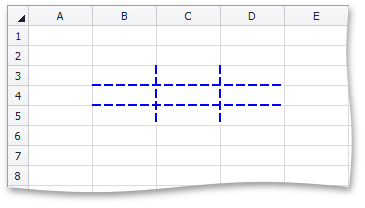CellRange.SetInsideBorders(Color, BorderLineStyle) Method
Sets all inside borders of the cell range.
Namespace: DevExpress.Spreadsheet
Assembly: DevExpress.Spreadsheet.v25.2.Core.dll
NuGet Package: DevExpress.Spreadsheet.Core
Declaration
Parameters
| Name | Type | Description |
|---|---|---|
| color | Color | A Color value specifying the line color of borders. |
| style | BorderLineStyle | A BorderLineStyle enumeration member specifying the line style of borders. |
Remarks
Use the SetInsideBorders method to set all borders within a range of cells.

To specify other sets of borders (e.g., outside, vertical or horizontal borders) or each particular border (e.g., bottom, top, left or right), use the corresponding properties and methods of the Borders object. For example, to specify borders around an entire range of cells, call the Borders.SetOutsideBorders method. To set both inside and outside borders of a range in one step, call the Borders.SetAllBorders method.
Access and modify the Borders object within the CellRange.BeginUpdateFormatting - CellRange.EndUpdateFormatting paired method calls. For details, refer to the How to: Add and Remove Cell Borders and How to: Format a Cell or Range of Cells documents.
To share the same cell border settings between multiple cell ranges in one step, apply a style via the CellRange.Style property.
Example
This example demonstrates how to specify different borders for individual cells and ranges of cells by modifying the Borders object.
Worksheet worksheet = workbook.Worksheets[0];
// Set each particular border for the cell.
Cell cellB2 = worksheet.Cells["B2"];
Borders cellB2Borders = cellB2.Borders;
cellB2Borders.LeftBorder.LineStyle = BorderLineStyle.MediumDashDot;
cellB2Borders.LeftBorder.Color = Color.Pink;
cellB2Borders.TopBorder.LineStyle = BorderLineStyle.MediumDashDotDot;
cellB2Borders.TopBorder.Color = Color.HotPink;
cellB2Borders.RightBorder.LineStyle = BorderLineStyle.MediumDashed;
cellB2Borders.RightBorder.Color = Color.DeepPink;
cellB2Borders.BottomBorder.LineStyle = BorderLineStyle.Medium;
cellB2Borders.BottomBorder.Color = Color.Red;
// Set all borders for cells.
Cell cellC4 = worksheet.Cells["C4"];
cellC4.Borders.SetAllBorders(Color.Orange, BorderLineStyle.MediumDashed);
Cell cellD6 = worksheet.Cells["D6"];
cellD6.Borders.SetOutsideBorders(Color.Gold, BorderLineStyle.Double);
// Set all borders for the range of cells in one step.
CellRange range1 = worksheet.Range["B8:F13"];
range1.Borders.SetAllBorders(Color.Green, BorderLineStyle.Double);
// Set all inside and outside borders separately for the range of cells.
CellRange range2 = worksheet.Range["C15:F18"];
range2.SetInsideBorders(Color.SkyBlue, BorderLineStyle.MediumDashed);
range2.Borders.SetOutsideBorders(Color.DeepSkyBlue, BorderLineStyle.Medium);
// Set all horizontal and vertical borders separately for the range of cells.
CellRange range3 = worksheet.Range["D21:F23"];
Formatting range3Formatting = range3.BeginUpdateFormatting();
Borders range3Borders = range3Formatting.Borders;
range3Borders.InsideHorizontalBorders.LineStyle = BorderLineStyle.MediumDashDot;
range3Borders.InsideHorizontalBorders.Color = Color.DarkBlue;
range3Borders.InsideVerticalBorders.LineStyle = BorderLineStyle.MediumDashDotDot;
range3Borders.InsideVerticalBorders.Color = Color.Blue;
range3.EndUpdateFormatting(range3Formatting);
// Set each particular border for the range of cell.
CellRange range4 = worksheet.Range["E25:F26"];
Formatting range4Formatting = range4.BeginUpdateFormatting();
Borders range4Borders = range4Formatting.Borders;
range4Borders.SetOutsideBorders(Color.Black, BorderLineStyle.Thick);
range4Borders.LeftBorder.Color = Color.Violet;
range4Borders.TopBorder.Color = Color.Violet;
range4Borders.RightBorder.Color = Color.DarkViolet;
range4Borders.BottomBorder.Color = Color.DarkViolet;
range4.EndUpdateFormatting(range4Formatting);